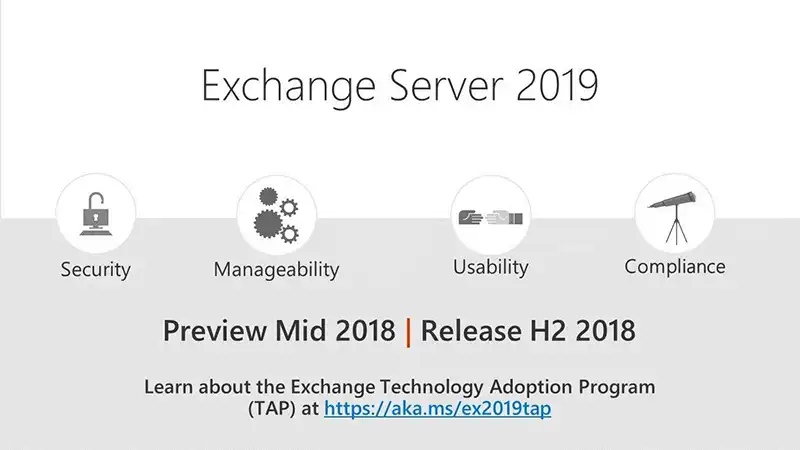Microsoft Announces Exchange Server 2019 – COMING SOON !
Microsoft announced its plans for the next Latest Version of MS Exchange Server, at Ignite 2017 conference and called Microsoft Exchange Server 2019. This comes as a significant milestone for Microsoft that will mark its 10th product edition. It simply means Exchange is 21 years old. In mid-2018 a preview of MS Exchange 2019 will be available and release is targeted in the second half of 2018. The typical release cadence for Exchange Server being done every 3 years, with RTM of the latest version. In late 2015 Exchange 2016 was released, Exchange 2013 was released in late 2012 and Exchange 2010 was released in 2009.

Development for Exchange has followed a pattern of advanced Exchange Server 2019 Features arriving in Exchange Online first and then, makes its way to on-premises customers by cumulative updates or as an entirely new release. For Example, In the Exchange 2013 era, some cloud improvements did not arrive on-premises until the 2016 release.
Although at this stage Microsoft is not making any explicit announcements. This will not stop users from speculating as to what they will see in Microsoft Exchange Server 2019. Many of the innovation born in the cloud with Exchange Online that will be included in Exchange 2019. Besides this, it is not an official statement but they were very clear that security, manageability, compliance, and usability from Exchange Online will all be present in Exchange Server 2019.
Some Upcoming Exchange Server 2019 Features
After reviewing Microsoft’s timeline for Exchange Server 2019 release, and some of its other product matrices. One can come up with the following predictions. These are just some speculation based on knowledge and are not set in stone:

• The minimum operating system and Active Directory requirements will exclude any that are out of mainstream support. This would result in making Windows Server 2012 R2 the minimum OS and AD for Exchange Server 2019, if MS Exchange RTMs before October 2018 when Windows 2012 R2 goes in extended support. Users may get the minimum requirements set to Windows Server 2016 instead.
• MAPI over HTTP Exchange will the default and only communication protocols. It means that features that were deprecated in Exchange 2016 will be removed entirely in MS Exchange Server 2019. This will reflect the end of RPC-over-HTTP, which has been replaced by an improved MAPIhttp protocol. Since MAPIhttp was supported by different types of Outlook clients that are present in the mainstream or extended support today, there is no need to retain RPC-over-HTTP protocol.
• Outlook 2013 will be the minimum supported email client. This means that Office 2013 may be out of mainstream support by the time Exchange Server 2019 RTMs. But while it is acceptable to require the latest operating system for a Microsoft Exchange Server 2019. It is a totally different beast to require customers for upgrading the entire Office client deployment.
• The Outlook on the Web will be updated to the recent Exchange Online users experience.
• Microsoft will squeeze some more performance improvements out of the database engine. Storage IOPS and search performance has been improved in Exchange 2016 and will increase the maximum hardware specification that one can scale a single Exchange server up to. A scale is provided that Exchange server 2019 Online runs at, there is no doubt that Microsoft is always working on the several ways to improve these even further. Benefits can be expected by on-premises customer as well.
• There will be no change in the server role architecture. Since Exchange 2010, the database availability group (DAG) has been the high availability and site resilience model and is the basis of the HA/SR in Exchange Online. As an available role to meet all needs of the customers, Edge Transport will also be present.
• There will be an improvement in the scalability for public folders, but feature-wise they will remain largely the same in Microsoft Exchange Server 2019.
• Cross-premises challenges of the hybrid deployment like calendar sharing, mailbox permission, delegates etc. will continue to improve. That means that Hybridization will likely become easier.
• As users have seen the capability of Exchange 2013 and 2016 with side-by-side, the migrations will be seamless.
Wrapping it up
Microsoft is dedicated to provide various solutions for on-premises customers i.e., Exchange Server 2019, even though they continue to drive and design for cloud innovation. Users expect that MS Exchange 2019 should follow the architecture of Exchange 2016 and includes some special features of Office 365. It is also predicted that there will be no legacy interoperability for legacy Outlook or legacy Exchange. After comparing and understanding features of the previous version of Exchange Server, we have just predicted new Exchange Server 2019 Features. So, that user can get an overview of the upcoming features in the Microsoft Exchange Server 2019.

